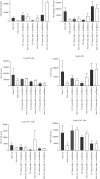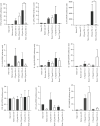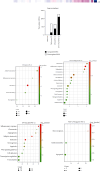Cystic Fibrosis Mice Are Highly Susceptible to Repeated Acute Pseudomonas aeruginosa Pneumonia after Intranasal Inoculation
- PMID: 38347907
- PMCID: PMC10861279
- DOI: 10.1155/2024/4769779
Cystic Fibrosis Mice Are Highly Susceptible to Repeated Acute Pseudomonas aeruginosa Pneumonia after Intranasal Inoculation
Abstract
Cystic fibrosis (CF) is a genetic disorder caused by mutations in the cystic fibrosis transmembrane conductance regulator (CFTR) that controls chloride current. A number of different CFTR transgenic mouse lines have been developed and subjected to both acute and chronic infection models. However, prior studies showed no substantial differences in bacterial clearance between CF and non-CF mice after single inoculations. Here, using F508del transgenic CF mice, we examined the role of repeated acute Pseudomonas aeruginosa (PA) infection, with the second inoculation 7 days after the first. We found that CF mice were more susceptible to PA infection than non-CF mice following the second inoculation, with non-CF mice showing better neutrophil recruitment and effector functions. We further investigated the characteristics of lung immune cells using single-cell RNA sequencing, finding that non-CF lung neutrophils had more prominent upregulation of adhesion molecules including intercellular adhesion molecule-1 (ICAM-1) compared to CF lung neutrophils. Although people with CF are often colonized with bacteria and have high numbers of neutrophils in the airways during chronic infection, these data suggest that CF neutrophils have deficient effector functions in the setting of repeated acute infection.
Copyright © 2024 Mariel Manzor et al.
Conflict of interest statement
The authors declare that they have no conflicts of interest.
Figures







Similar articles
-
Cysteamine re-establishes the clearance of Pseudomonas aeruginosa by macrophages bearing the cystic fibrosis-relevant F508del-CFTR mutation.Cell Death Dis. 2017 Jan 12;8(1):e2544. doi: 10.1038/cddis.2016.476. Cell Death Dis. 2017. PMID: 28079883 Free PMC article.
-
Transgenic cystic fibrosis mice exhibit reduced early clearance of Pseudomonas aeruginosa from the respiratory tract.J Immunol. 2001 Jun 15;166(12):7410-8. doi: 10.4049/jimmunol.166.12.7410. J Immunol. 2001. PMID: 11390493
-
Mouse models of chronic lung infection with Pseudomonas aeruginosa: models for the study of cystic fibrosis.Pediatr Pulmonol. 2000 Nov;30(5):413-24. doi: 10.1002/1099-0496(200011)30:5<413::aid-ppul8>3.0.co;2-9. Pediatr Pulmonol. 2000. PMID: 11064433 Review.
-
Acute intratracheal Pseudomonas aeruginosa infection in cystic fibrosis mice is age-independent.Respir Res. 2011 Nov 7;12(1):148. doi: 10.1186/1465-9921-12-148. Respir Res. 2011. PMID: 22059807 Free PMC article.
-
Harnessing Neutrophil Survival Mechanisms during Chronic Infection by Pseudomonas aeruginosa: Novel Therapeutic Targets to Dampen Inflammation in Cystic Fibrosis.Front Cell Infect Microbiol. 2017 Jun 30;7:243. doi: 10.3389/fcimb.2017.00243. eCollection 2017. Front Cell Infect Microbiol. 2017. PMID: 28713772 Free PMC article. Review.
References
MeSH terms
Substances
Grants and funding
LinkOut - more resources
Full Text Sources
Medical
Miscellaneous

